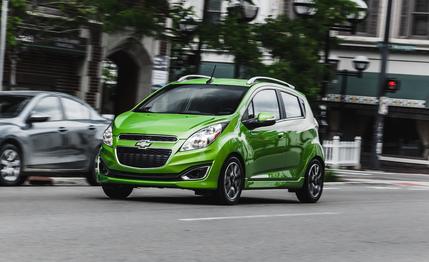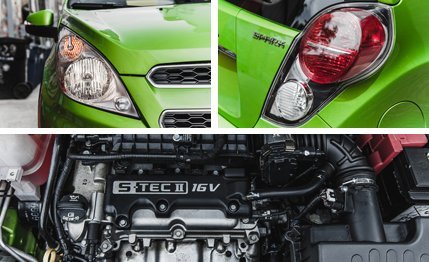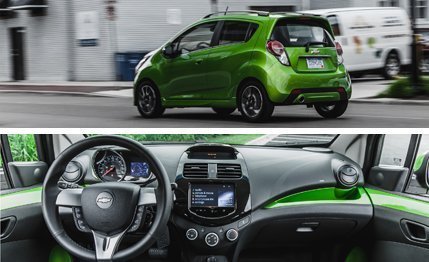 Instrumented Test
Instrumented Test
Although automakers such as Honda and Nissan have made significant strides in quelling the continuously variable transmission’s more annoying aspects—a tendency to cause engine droning and a disconnected sensation between said engine and the drive wheels—we’re still generally unimpressed with the technology. And we find in most cases that the promises of greater fuel economy made by CVTs doesn’t translate to the real world. But we can get behind replacing a four-speed automatic with just about anything, so bring on the CVT-equipped 2014 Chevrolet Spark.
We evaluated a manual-equipped Spark last year and found that licking any glue from the 84-hp 1.2-liter four-cylinder’s microscopic performance envelope was futile, but driving it was very nearly fun. Sparks with the old four-speed automatic weren’t fun at all, however, so we were intrigued by Chevrolet’s claim that the new CVT is “designed to improve fuel efficiency and acceleration, for a more pleasurable driving experience.”

In a remarkable twist, the new CVT actually makes the Spark quicker. Compared with the manual Spark, the CVT car chopped 0.2 second from the run to 60 mph. It still took a glacial 11.0 seconds to get there, but improvement is improvement, right?
Perhaps more interesting is the CVT’s novel design. Chevrolet calls it a “two-step” CVT, on account of the transmission’s two output ratios added to the two-pulley-and-a-belt setup. The unit can choose to route torque from the output pulley through a low ratio for quicker acceleration or a taller one for calmer highway cruising. Regardless of which output is chosen, the CVT’s pulley ratios can vary infinitely between 2.20:1 and 0.55:1. The 3.75:1 final drive is taller than the old automatic’s 4.15:1 ratio, helping to bump the Spark’s EPA city/highway fuel-economy estimates by 2 mpg each, to 30/39. We recorded a considerably less-thrifty 27 mpg due to our enthusiastic driving style. Your mileage will undoubtedly vary upward.
In terms of smoothness, the CVT is a massive improvement over the old automatic, and it allows you to better exploit the Spark’s meager output. Flooring the throttle sends the car’s digital tachometer bars shooting toward redline, where engine speed remains while the CVT sorts out the appropriate ratio and road speed slowly builds. Keep it planted long enough and there is a distinct but buttery upshift when the trans chooses the taller output ratio. It’s not obtrusive, and it lends this CVT more of a “normal automatic” feeling without resorting to fake “gears,” as some manufacturers do with their variable transmissions.

The absence of shifting duties and the relative quietness of the Spark’s interior, however, provide the driver with more time to focus on the car’s dynamic shortcomings. Braking from 70 mph takes a long 177 feet and is accompanied by enthusiastic tail wagging thanks to the car's short wheelbase. Around our skidpad, the Spark gave up in a howl of understeer at just 0.81 g. While it is nimble around town, the Spark as a whole just isn’t as pleasurable to drive as, say, the equally underpowered Mazda 2.
Aside from its new CVT, the 2014 Spark is essentially unchanged. It has a roomy and well-appointed interior that can fit four real-size humans in relative comfort, and there are lots of “vibrant” exterior colors to choose from. Our option-free, top-of-the-line Spark 2LT (standard 15-inch aluminum wheels, Chevy’s slick touch-screen MyLink setup, and six, count ’em six, audio speakers) was painted Lime, an appropriately named hue that made our car look like something we’d slice up and plop into a gin and tonic.
We’d stick with the base LS or 1LT trim levels, as our test example’s $17,210 sticker nuzzles those of the larger and better Chevy Sonic, Ford Fiesta, and Honda Fit. Those cars all roughly match or beat the CVT-equipped Spark’s efficiency while offering space for a fifth passenger, the stability of a larger footprint, and more rewarding handling. But stay on the cheaper side of things and the CVT Spark makes sense. No, we can’t believe we typed those words, either.